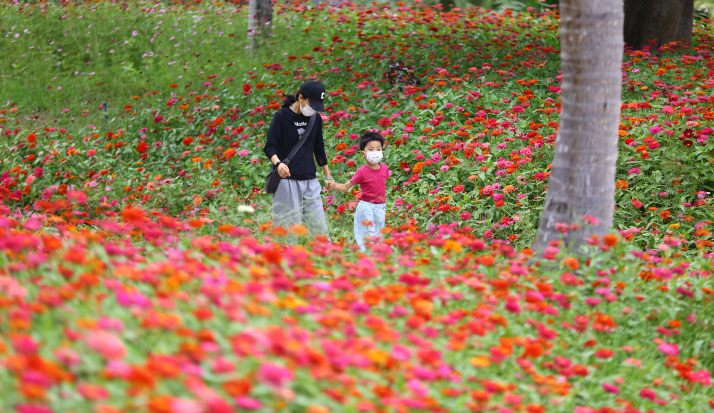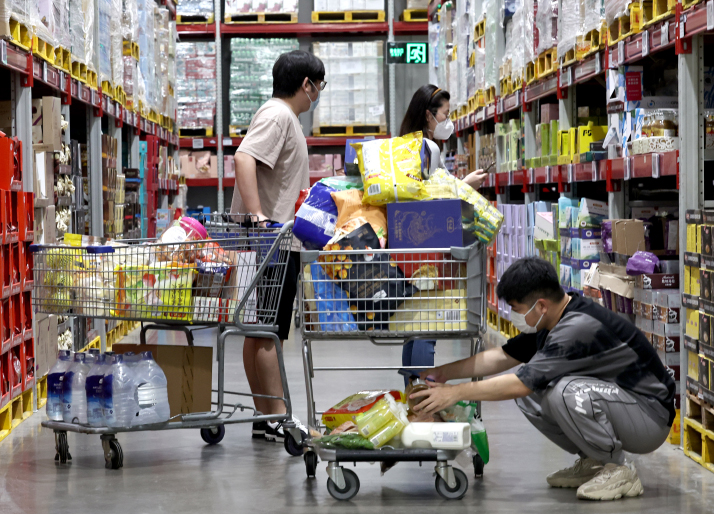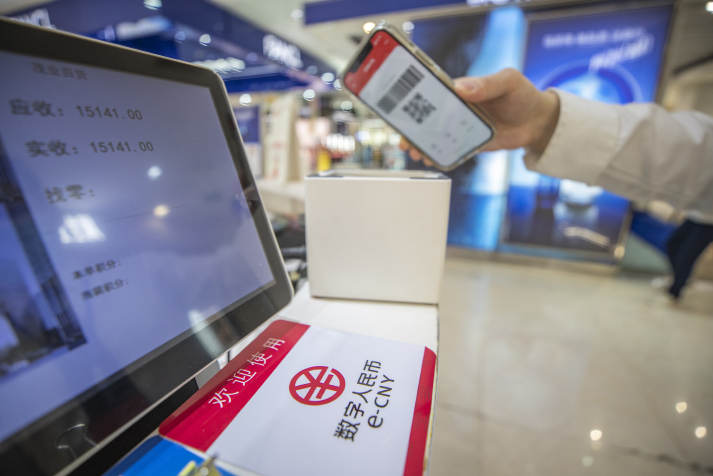| Business |
| Amid pandemic flare-ups, who gets into consumer pockets? | |
|
|
 Visitors enjoy the floral scenery at a scenic site in Sanya, Hainan Province, on May 3 (XINHUA)
Cheng Cheng, a 29-year-old Beijing resident, is a hands-on woman who has poured great effort into planning her dream wedding, originally set to take place in May. But due to a COVID-19 resurgence in China's capital, the wedding bells will have to ring at a later time. To rub salt in the wound, her honeymoon plans in the southwestern province of Yunnan, too, have to be rescheduled. "We already had to settle for 'second-best,' due to international travel restrictions, so we opted for Yunnan," Cheng told Beijing Review. "It's a real shame, but maybe once we regroup and get this wedding show on the road, we can choose another [domestic] destination." Following two years of pandemic restrictions and resurgences across China, pent-up demand to travel freely again, or as freely as can be under COVID-19 limitations, has resulted in a strong consumer desire to make up for lost time—and opportunities. Trekking on China has indeed witnessed the emergence of several new models and trends in response to the "to travel or not to travel" dilemma. The May Day holiday used to be one of the country's busiest travel seasons. This year, the national five-day break from April 30 to May 4 coincided with COVID-19 flare-ups in several megacities, including Beijing and Shanghai, forcing many to cancel their travel plans altogether. Enter: the rise of the city walk. This budding tourism model scratches the urban dwellers' consumption itch or, in other words, provides a solution which shortens travel distance but expands its depth. In short, tourists go on a group tour exploring the urban surroundings under the knowledgeable guidance of artists, historians or architects. According to online travel agency Trip.com Group, 40 percent of city walk fans on the platform are under 30. These youngsters are keen to discover niche destinations that are well-kept secrets—some even rarely known among locals. Industry insiders predict the travel niche has a bright future ahead. Camping proves another popular choice. The genre has gained wider popularity since 2020 and the number of outdoor aficionados remains on the up. According to Dianping.com, China's Yelp, "camping" searches during the holiday jumped 151 percent compared to the numbers over the five days leading up to it, nearly threefold from last year. "With the impact of pandemic control and prevention measures, short-distance and in-depth local travels have become the main trends. Tourists from giant cities are flowing to suburban rural areas," Wu Ruoshan, a researcher with the Tourism Research Center at the Chinese Academy of Social Sciences, told China Economic Times in April. In low-risk areas of COVID-19, tours to culture-themed scenic spots, museums and intangible cultural heritage demonstration sites also mark holiday highlights. Young people attach more importance to cultural spots and interactive experiences, according to Trip.com Group. Noticeably, tourism-related online retail sales went up 371.2 percent year on year during the May Day holiday, data from the Ministry of Commerce showed on May 5. "The emergence of new products and trends tells us that right now tourism wins through innovation instead of costly promotional campaigns. It's crucial to develop programs that suit local market conditions, meet consumer needs and align with investors' financial capacity," Xiong Xiaojie, president of a cultural tourism company based in Guangzhou, Guangdong Province, wrote in his article published on Qinshuo's Friends, a business news channel on Chinese super-app WeChat, in April.  Shoppers get groceries at a supermarket in Shanghai on May 2 (XINHUA)
Consumer confidence Tourism is a microcosm of the overall economy. Newly sprouting business models and trends, which might continue or disappear once the virus finally fades into oblivion, are altering Chinese people's lifestyles. Consumer appreciation for original alternatives can in turn present effective ideas and outlines for business innovation. Nevertheless, the pandemic has greatly undermined consumer confidence. Consumer spending is a primary engine for China's economic growth. Final consumption in the first quarter of this year contributed 69.4 percent to GDP expansion, which stood at 4.8 percent year on year. "Over recent decades, consumption has been the main force driving the expansion of domestic demand. Following the impact of COVID-19, China faces great downward pressures on consumption, but there are still many fields to be utilized," Kong Lingchi, an assistant research fellow with the Yangtze IDEI Research Group at Nanjing University, told Beijing Review. The government has rolled out a good deal of measures to stimulate consumption and boost confidence, tackling short-term bottlenecks and trying to invigorate longer-term consumption vitality. According to Jiemian, a Shanghai-based digital media outlet, 19 provinces have issued 43 kinds of consumption coupons totaling about 5 billion yuan ($750 million) since April. During the May Day holiday, many regions free of local COVID-19 infections introduced travel incentives and hosted promotional events. Scenic areas also offered big discounts or free tickets to attract tourists. Thanks to the supportive policies, the tourism sector has seen several noteworthy successes. The Wulingyuan Scenic Area and Tianmen Mountain in Zhangjiajie, Hunan Province, offered free tickets to provincial residents. In the first three days of the May Day holiday, over 50,000 visits were made to Zhangjiajie, and bed and breakfast bookings increased 43-fold from the previous week. The southern island province of Hainan distributed consumption coupons worth roughly 130 million yuan ($19.3 million) for shopping, dining and tourism during the holiday. According to the provincial commerce department, sales revenue of Hainan's 298 major retail enterprises and 72 major restaurant brands reached 2.02 billion yuan ($303 million) throughout the same period, up 0.6 percent year on year. "We used the coupons to buy duty-free products; it's a great deal," Li Xueru, a visitor from Shenzhen, Guangdong, told Xinhua News Agency. In terms of longer-term vitality, consumer confidence in economic recovery and growth is crucial. Zhao Pin, deputy head of the China Council for the Promotion of International Trade, said, "The stability of income is key to stabilizing consumption at the current stage and boosting overall purchasing power in the long term." Chinese consumers are relatively more optimistic about the future, in sharp contrast to the declining global consumer confidence, read a recent report published by global consulting firm Ernst & Young. Approximately 60 percent of Chinese respondents believed their personal finances would improve in the coming year, higher than the global average of 48 percent. Kong further emphasized consumers today require more diverse and high-quality options to choose from: intelligent consumption like an unmanned grocery store; customized consumption including online services for tailor-made clothes, shoes and furniture; experiential consumption with a prime example being IKEA's augmented reality mobile application that allows users to try products in real time; and shared consumption, e.g. ride sharing. "Those taking into account these factors will be the ones getting into Chinese consumer pockets in the post-pandemic era," he concluded.  A consumer pays by e-CNY, or digital renminbi, at a shopping mall in Jiangbei District, Chongqing Municipality, on May 3(XINHUA)
Comeback kid Currently, the most effective method to boost consumption will be putting a stop to the highly transmissible COVID-19 Omicron variant. In 2021, China's May Day holiday saw a travel boom with the number of passenger trips on Chinese railways hitting a new single-day high on May 1, with nearly 18.83 million trips recorded, up 9.2 percent from the pre-COVID-19 level in 2019, statistics by the National Bureau of Statistics showed. This was an encouraging sign of post-pandemic revival. The boom was attributed to the clearance of at-risk areas nationwide which had eased overall pandemic anxiety. This year, thanks to China's dynamic zero-COVID-19 policy, ubiquitous flare-ups since March are being curbed in the shortest possible time. Specifically, the policy means that in the event of a new local resurgence, measures will be taken to promptly halt the spread of the virus. Social and business activities are gradually going back to normal in regions with severe resurgences. Changchun and Jilin cities in the northeastern province of Jilin have gradually been toning down citywide closed-off management from April 28 onward. Areas subject to lockdown management in Shanghai are shrinking following continuous drops in both confirmed and asymptomatic local case numbers. The risk of the virus spreading in Beijing has been reduced via the adoption of regional nucleic acid testing and the monitoring of close contacts. "It's necessary to accelerate the response to resurgences in some parts of the country and improve related methods," Wu said. "The dynamic zero-COVID-19 approach has proven effective," said Li Bin, deputy head of the National Health Commission, noting that the stabilizing situation has provided a favorable environment for sound economic performance. Already on the up after being shocked by COVID-19 lockdowns and health fears that severely curtailed spending on services, consumption is surely poised for a grand comeback. (Print Edition Title: The Consumption Itch) Copyedited by Elsbeth van Paridon Comments to zhangshsh@cicgamericas.com |
|
||||||||||||||||||||||||||||||
|